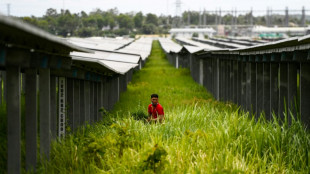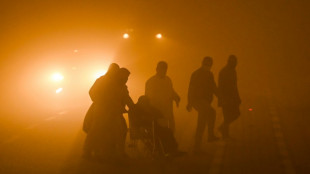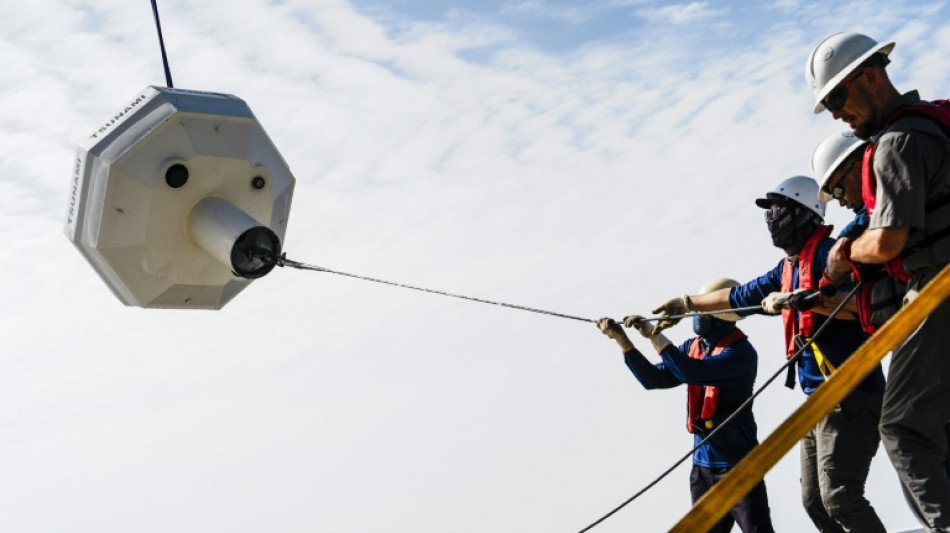
-
 T'Wolves dominate Lakers, Nuggets edge Clippers as NBA playoffs start
T'Wolves dominate Lakers, Nuggets edge Clippers as NBA playoffs start
-
Taxes on super rich and tech giants stall under Trump

-
 Star Wars series 'Andor' back for final season
Star Wars series 'Andor' back for final season
-
Neighbours improvise first aid for wounded in besieged Sudan city
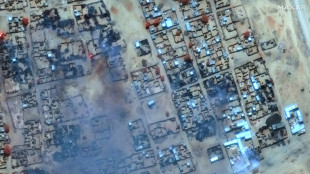
-
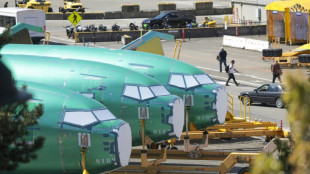 Tariffs could lift Boeing and Airbus plane prices even higher
Tariffs could lift Boeing and Airbus plane prices even higher
-
Analysts warn US could be handing chip market to China

-
 Unbeaten Miami edge Columbus in front of big MLS crowd in Cleveland
Unbeaten Miami edge Columbus in front of big MLS crowd in Cleveland
-
Social media helps fuel growing 'sex tourism' in Japan
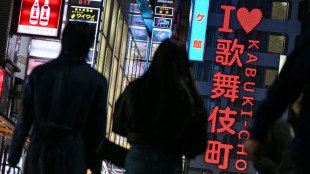
-
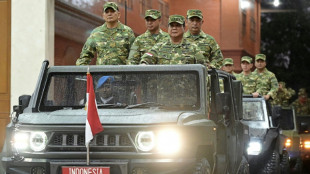 'Pandora's box': alarm bells in Indonesia over rising military role
'Pandora's box': alarm bells in Indonesia over rising military role
-
Alaalatoa hails 'hustling hard' Brumbies for rare Super Rugby clean sheet

-
 Trio share lead at tight LA Championship
Trio share lead at tight LA Championship
-
Sampdoria fighting relegation disaster as old heroes ride into town

-
 Recovering pope expected to delight crowds at Easter Sunday mass
Recovering pope expected to delight crowds at Easter Sunday mass
-
Nuggets edge Clippers in NBA playoff overtime thriller, Knicks and Pacers win

-
 Force skipper clueless about extra-time rules in pulsating Super Rugby draw
Force skipper clueless about extra-time rules in pulsating Super Rugby draw
-
Nuggets edge Clippers in NBA playoff overtime thriller, Pacers thump Bucks

-
 Unbeaten Miami edge Columbus in front of big crowd in Cleveland
Unbeaten Miami edge Columbus in front of big crowd in Cleveland
-
Kim takes one-shot lead over Thomas, Novak at RBC Heritage

-
 Another round of anti-Trump protests hits US cities
Another round of anti-Trump protests hits US cities
-
'So grateful' - Dodgers star Ohtani and wife welcome first child

-
 PSG maintain unbeaten Ligue 1 record, Marseille back up to second
PSG maintain unbeaten Ligue 1 record, Marseille back up to second
-
US, Iran report progress in nuclear talks, will meet again

-
 US Supreme Court intervenes to block Trump deportations
US Supreme Court intervenes to block Trump deportations
-
Hamas armed wing says fate of US-Israeli captive unknown

-
 Pacers thump Bucks to open NBA playoffs
Pacers thump Bucks to open NBA playoffs
-
Sabalenka reaches Stuttgart semis as Ostapenko extends Swiatek mastery

-
 Zelensky says Ukraine will observe Putin's Easter truce but claims violations
Zelensky says Ukraine will observe Putin's Easter truce but claims violations
-
'Fuming' Watkins fires Villa in bid to prove Emery wrong

-
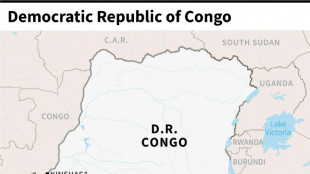 DR Congo boat fire toll revised down to 33
DR Congo boat fire toll revised down to 33
-
England thrash Scotland to set up France Grand Slam showdown

-
 Verstappen's Red Bull 'comes alive' to claim record pole in Jeddah
Verstappen's Red Bull 'comes alive' to claim record pole in Jeddah
-
McTominay fires Napoli level with Inter as Conte fuels exit rumours

-
 Rajasthan unleash Suryavanshi, 14, as youngest IPL player but lose thriller
Rajasthan unleash Suryavanshi, 14, as youngest IPL player but lose thriller
-
Man City boost top five bid, Aston Villa thrash in-form Newcastle

-
 Villa rout Newcastle to rekindle bid to reach Champions League
Villa rout Newcastle to rekindle bid to reach Champions League
-
Dumornay gives Lyon lead over Arsenal in Women's Champions League semis

-
 Trans rights supporters rally in London, Edinburgh after landmark ruling
Trans rights supporters rally in London, Edinburgh after landmark ruling
-
'We have to wait': Barca's Flick on Lewandowski injury fear

-
 Bordeaux-Begles backups edge Pau to close in on Top 14 summit
Bordeaux-Begles backups edge Pau to close in on Top 14 summit
-
Trans rights supporters rally outside in London, Edinburgh after landmark ruling

-
 PSG beat Le Havre to stay on course for unbeaten Ligue 1 season
PSG beat Le Havre to stay on course for unbeaten Ligue 1 season
-
Man City close in on Champions League with Everton late show

-
 14-year-old Vaibhav Suryavanshi becomes youngest IPL player
14-year-old Vaibhav Suryavanshi becomes youngest IPL player
-
Barca make stunning comeback to beat Celta Vigo in Liga thriller

-
 Zverev sets up birthday bash with Shelton in Munich
Zverev sets up birthday bash with Shelton in Munich
-
Man City boost top five bid, Southampton snatch late leveller

-
 US Supreme Court intervenes to pause Trump deportations
US Supreme Court intervenes to pause Trump deportations
-
Alcaraz and Rune race into Barcelona final

-
 US, Iran to hold more nuclear talks after latest round
US, Iran to hold more nuclear talks after latest round
-
Man City close in on Champions League thanks to Everton late show


The tsunami detection buoys safeguarding lives in Thailand
Almost 1,000 kilometres off the Thai coast devastated by a tsunami 20 years ago, engineers lower a detection buoy into the waves -- a key link in a warning system intended to ensure no disaster is as deadly again.
On December 26, 2004, a magnitude 9.1 earthquake under the Indian Ocean triggered a huge tsunami with waves up to 30 metres (100 feet) high.
Only a rudimentary warning system was in place at the time, with no way to alert the millions of people living around the Indian Ocean in advance. More than 225,000 people were killed in a dozen countries.
In the years following the disaster, multiple governments developed a global tsunami information system, building on the US National Oceanic and Atmospheric Administration's (NOAA) network of six detection buoys in the Pacific.
Known as Deep-Ocean Assessment and Reporting of Tsunamis (DART), the system now has 74 buoys around the world.
Each floats on the surface while tethered to the seabed, monitoring signals from a seismic sensor on the ocean floor and changes in the water level.
Installed in some of the toughest working environments anywhere on the planet, the battery-powered buoys must be replaced every two years. Only 50 of the devices are currently operational but the network has been designed to provide coverage regardless.
The Thai research vessel M.V. SEAFDEC crew gently lowered a replacement buoy -- a yellow cylinder about two metres in diameter -- this month into the Indian Ocean 965 kilometres (600 miles) offshore.
- Five-minute warning -
The same team also sought to replace a closer buoy in the Andaman Sea, 340 kilometres from the coast, but were unsuccessful and will mount a new mission in the coming weeks.
Shawn Stoeckley, a mechanical engineer from buoy manufacturers Science Applications International Corporation (SAIC), calibrates the system from his laptop on board before it is deployed.
"I feel that it has a lot of purpose, that it can save coastal lives," he told AFP.
The 2004 tsunami killed more than 5,000 people in Thailand, according to official figures, with 3,000 missing.
Now the country's two DART buoys are linked by satellite to a nationwide network of 130 alarm towers equipped with sirens and loudspeakers that can broadcast in five languages in coastal provinces.
Residents in disaster-prone areas also receive an SMS alert of an imminent tsunami, warning them to evacuate quickly.
Before 2004, it would take anywhere from 15 to 50 minutes before an alarm could be issued, says Laura Kong, director of UNESCO's International Tsunami Information Center.
"Today it's typical we would get something within five to seven minutes," she said.
One day, say UN experts, the system will prove essential.
There is a "100 percent chance" of another tsunami on the scale of 2004 at some point, Bernardo Aliaga, UNESCO's head of Tsunami Resilience Section, told an anniversary conference, adding it "could be tomorrow or in 50 years or 100 years".
- False alarms -
Mobile phones have become ubiquitous and disaster apps widely available in the years since the tsunami, but locals say the towers are still vital.
Songsil Nodharith, 51, head of Khuek Khak village, helped residents to evacuate "without even grabbing their belongings" during a night-time false alarm last year and urged authorities to ensure that the towers were well maintained.
In Sri Lanka -- where 31,000 were killed in 2004, making it the second-worst-hit country -- more than three-quarters of the 77 tsunami warning towers the government subsequently installed are not operating because the communications equipment has become obsolete, the island's Disaster Management Centre chief Udaya Herath told AFP.
Mobile phone companies have instead identified some 70,000 "key contacts" in coastal areas, including resort managers, to receive warnings and evacuation orders in the event of impending danger.
Warnings have occasionally set off panic in Thailand, with locals and tourists rushing for higher ground, but residents have faith in the system.
The fishing village of Ban Nam Khem saw Thailand's worst destruction in 2004, with trawlers swept onto houses and 800 residents killed.
Manasak Yuankaew, 48, now head of the village, lost four members of his family that day.
"We have a saying here," he told AFP. "Fleeing 100 times is better than not fleeing that one crucial time."
A.Ruegg--VB


